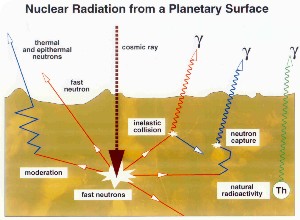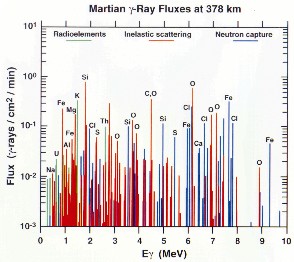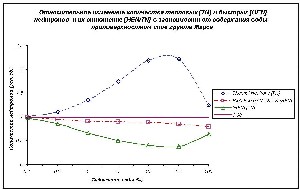|
The nature of neutron and gamma emission from the Mars surface Mars has a thin atmosphere and has no global magnetic field. Therefore, cosmic rays freely propagate through its atmosphere and interact with the surface. Nuclei of the subsurface planetary layer with the thickness of 1-3 m produce a large number of secondary neutrons under the bombardment by cosmic rays. Neutrons propagate out from the layer and interact on the way with subsurface matter. Two types of nuclear reactions take place between outgoing neutrons and nuclei: inelastic scattering, when they are fast, and capture, when they have epithermal or thermal energies [1] (see Figure 1). The flux of secondary neutrons from the surface is the neutron albedo of Mars. |
|
Figure 1. Nuclear reactions take place in the subsurface layer of Mars under bombardment of cosmic rays (to see more, click on picture) |
|
Due to these reactions, nuclei radiate gamma rays. The nucleus of each chemical element produces a unique set of gamma-ray lines, and the method of gamma-spectroscopy allows identifying the presence and relative quantity of chemical elements in the sample. According to numerical calculation [1], the surface of Mars emits gamma rays as a “forest” of nuclear lines from the main chemical elements of the planet’s surface (see Figure 2). |
|
Figure 2. Calculated “forest” of nuclear lines from the surface of Mars, which are produced by naturally radioactive elements 19K, 92U and 90Th, or with inelastic scattering of high energy neutrons, or with capture of thermal neutrons (see [1]). (to see more, click on picture) |
|
The greater part of these lines is a result
of nuclei excitation by secondary neutrons, and some small part of them is
produced by natural radioactivity from nuclei of elements K, U and Th. Generally
speaking, the spectrum of these lines unambiguously characterizes the
composition of the subsurface layer of Mars at each observation point.
Gamma spectroscopy of Mars: research of elements composition of planet The first direct measurements of gamma-rays from Mars orbit were performed by scintillation detectors on board the Soviet space probes “Mars-5” in 1974 and “Phobos-2” in 1989 [2-4]. They confirmed the presence of a heavy flux of gamma rays from Mars, but have not provided sufficient spectral resolution for detailed study of the chemical composition of planetary matter. The gamma-spectrometer with a detector of highly purified germanium allows measuring the spectrum of nuclear gamma lines with very high spectral resolution. This type of instrument should be used for determination of chemical composition of subsurface layer of Mars. The two attempts have been made to send to Mars this type of instrument. In 1992 the gamma-spectrometer GRS was sent to Mars as part of the NASA “Mars Observer” mission [5]. In 1996 the Russian-made instrument PGS, in collaboration with the United States, with two detectors of the high-purity germanium, was launched on the Russian-made spacecraft “Mars-96” [6]. Unfortunately, both missions failed. At the present time a new version of the germanium gamma-spectrometer GRS for spectroscopic high-resolution investigation is included in the payload of “2001 Mars Odyssey”. The main goal of the GRS experiment is the scanning of the Mars’ surface from a spacecraft and constructing the global map of the distribution of chemical elements on the Martian surface. This map will help us understand the origin and evolution of the surface at different regions of Mars, to study volcanic regions, to explore the North and South polar caps and to detect permafrost areas on Mars (see Table 1). Nuclear lines of primary elements of planetary matter are known to be emitted either by inelastic scattering or capture of secondary neutrons produced by cosmic rays. Therefore, the intensity of each gamma line depends on not only the corresponding nuclei, but depends on the spectral density of the flux of outgoing secondary neutrons. Thus, the knowledge of neutron albedo of Mars is necessary for accurate determination of the abundance of primary chemical elements and minerals by gamma spectroscopy. On the other hand, the energy spectrum of secondary neutrons at each point of Mars’ surface correspondently depends on the local composition of subsurface matter [7 – 9]. If only relatively heavy nuclei are present in the subsurface layer (O, Si, Ca, Fe, etc.), then secondary high-energy neutrons react with them mainly by inelastic scattering and they escape from the surface without loss of mach energy. In this case, gamma lines of exited nuclei dominate the gamma-ray spectrum (see Figure 2). However, if there are the nuclei of hydrogen or other light nuclei in the subsurface then energy of secondary high-energy neutrons are moderated down to thermal ones. Reactions of nuclear capture are more probable in this case, and in comparison with the spectrum of gamma lines of inelastic scattering the energy spectrum of emitted gamma lines will be formed. Therefore, comprehensive physical analyses are necessary for unambiguous determination of the abundance of chemical elements in the subsurface of Mars. They must include both high-resolution detection of nuclear lines and investigation of neutron albedo in a broad energy range from thermal energy up to MeV. To provide data on Martian neutron albedo, two instruments are included in the complex GRS, the Neutron Spectrometer (NS) and the High Energy Neutron Detector (HEND).
Neutron spectroscopy: the search for water ice Beside determination of neutron albedo parameters for interpretation of spectroscopic data of gamma-lines of nuclei, the neutron albedo data has independent significance. The ratio of high-energy neutrons and thermal neutrons depends significantly on the content of hydrogen nuclei and another light nuclei of chemical elements in the subsurface layer (see Figure 3) [7-9]. |
|
Figure 3. Relative variations of thermal neutrons TN, of high energy neutrons HEN and of their ratio HEN/TEN in dependence on content of water in subsurface layer of planetary mater (in per cents). (to see more, click on picture) |
|
It is known that water is the most widespread chemical substance, which contains the hydrogen. Therefore, the deficit of a high-energy component of neutron albedo above some point of the surface, which is accompanied by an excess of thermal neutrons, is evidence of the presence of ice or water. Therefore, the second important goal of the GRS experiment is construction of a global map of regions with subsurface water or ice by detecting variations of fluxes of fast and thermal neutrons (see Table 1).
Main expected results of the GRS experiment with participation of the Russian-made HEND Achievement of the goals of the GRS experiment with participation of the Russian-made instrument HEND will considerably advance Mars exploration:
Determination of these regions could be the most important achievement of the mission “2001 Mars Odyssey”, both for landing sites and for future space expeditions for the following reasons:
Therefore, the GRS experiment of “2001 Mars Odyssey” mission will provide important data for essential progress in Mars exploration, and the data from the Russian-made instrument HEND may contribute a valuable part of these results (see Table 1).
Additional science from investigation of cosmic gamma-ray bursts and solar flares The spectrometer GRS with the Russian-made detector HEND will be used also for additional astrophysical studies of cosmic gamma-ray bursts and solar flares. It is known that gamma-ray bursts (GRB) are high-energy impulses of gamma radiation, which have an astronomical origin [10-12]. This phenomenon was discovered in 1968 with the help of the American spacecraft series "VELA ". An important contribution to researching GRBs was made by experiments on Russian-made interplanetary spacecrafts “Venera” and “Phobos”. Of course, the detectors of GRS and HEND are not as sensitive as the special instruments in near-earth orbit because they were constructed under requirements on weight limitation for interplanetary spacecraft. However, the significance of detection of GRBs by detectors of “2001 Mars Odyssey” is related to the interplanetary distance of these devices to Earth. The data of “2001 Mars Odyssey” will be compared with the data of interplanetary space probe “Ulysses” and near-Earth satellites (“HETE-2”, “Wind”, etc.). This method of interplanetary triangulation allows determination of the position of sources of GRB with accuracy of several minutes of arc. In the last few year with the help of optical telescopes on Earth and computer systems for fast notification about the burst (the Gamma ray bursts Coordinate Network, or GCN) astronomers can detect new transient optical sources identified with GRBs (this phenomenon is named optical afterglow of GRB). Usually the searching for optical afterglow of GRBs is possible owing to accurate localization of X-ray afterglow of GRBs detected by space X-ray telescopes. Hence, the observation of optical afterglow has depended on registration of X-ray afterglow of the burst that has been detected. The data from the interplanetary spacecraft network will give precise localization of GRBs, and it allows searching for optical afterglow for the bursts, which have no X-ray afterglow at all. The discovery of this class of bursts, if confirmed, will help to clarify a very interesting problem of the existing of GRBs with optical afterglow, but for which X-ray afterglow is completely absent. The existence of this class of bursts would have quite important consequences for the theory of gamma ray burst emission. Another interesting opportunity of the spectrometer GRS with the Russian-made detector HEND is associated with the possibility to observe a solar flares from the different points of the Solar system. The simultaneous measurements of gamma rays and high-energy neutrons of powerful solar flare from the vicinity of Mars and from the vicinity of Earth allows a “stereoscopic image” of the active region on the Sun. Stereoscopic observation of powerful flares will give scientists the possibility to build a three-dimensional model of the generation of hard-electromagnetic radiation and corpuscular emission in active regions on the Sun. Therefore, the gamma-ray spectrometer GRS with participation of the Russian-made detector HEND will provide valuable astrophysical data both about the nature of gamma-ray bursts and about the physics of solar activity (see Table 1). |


